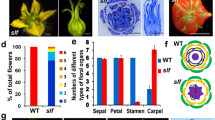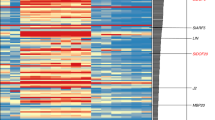Abstract
The characterisation of the single flower truss (sft) mutant phenotype of tomato (Lycopersicon esculentum Mill.), as well as its genetic interactions with other mutations affecting FALSIFLORA (FA) and SELF PRUNING (SP) genes, has revealed that SFT is a key gene in the control of floral transition and floral meristem identity. The single sft mutation produces a late-flowering phenotype in both long-day and short-day conditions. In combination with fa, a mutation affecting the tomato gene orthologous to LFY, sft completely blocks the transition to flowering in this species. Thus, the phenotype of the sft fa double mutants indicates that SFT and FA participate in two parallel pathways that regulate the switch from vegetative to reproductive phase in tomato, and that both genes are indispensable for flowering. On the other hand, the replacement of flowers by vegetative shoots observed in the sft inflorescence suggests that SFT regulates flower meristem identity during inflorescence development of tomato. In addition to these two main functions, SFT is involved in the development of both flowers and sympodial shoots of tomato. First, the mutation produces a partial conversion of sepals into leaves in the first floral whorl, and a reduction in the number of floral organs, particularly carpels. Secondly, the sympodial development in the mutant plants is altered, which can be related to the interaction between SFT and SP, a gene controlling the number of nodes in sympodial shoots. In fact, we have found that the sft phenotype is epistatic to that of sp, and that the level of SP mRNA in the apical buds of sft around flowering is reduced. SFT can therefore co-ordinate the regulation of two simultaneous developmental processes in the tomato apical shoot, the promotion of flowering in one sympodial segment and the vegetative development of the next segment.




Similar content being viewed by others
Abbreviations
- CAP:
-
cleavage amplified polymorphic (marker)
- fa:
-
falsiflora
- RT:
-
reverse transcription
- sft:
-
single flower truss
- sp:
-
self pruning
- WT:
-
wild type
References
Araki T (2001) Transition from vegetative to reproductive phase. Curr Opin Plant Biol 4:63–68
Atherton JG, Harris GP (1986) Flowering. In: Atherton JG, Rudich J (eds) The tomato crop. Chapman and Hall, London, pp 167–200
Blázquez MA, Weigel D (2000) Integration of floral inductive signals in Arabidopsis. Nature 404:889–892
Blázquez MA, Green R, Nilsson O, Sussman MR, Weigel D (1998) Gibberellins promote flowering of Arabidopsis by activating the LEAFY promoter. Plant Cell 10:791–800
Bowman HL, Alvarez J, Weigel D, Meyerowitz EM, Smith DR (1993) Control of flower development in Arabidopsis thaliana by APETALA1 and interacting genes. Development 119:721–743
Carpenter R, Copsey L, Vicent C, Doyle S, Magrath R, Coen E (1995) Control of flower development and phyllotaxy by meristem identity genes in Antirrhinum. Plant Cell 7:2001–2011
Ferrándiz C, Gu Q, Martienssen R, Yanofsky MF (2000) Redundant regulation of meristem identity and plant architecture by FRUITFULL, APETALA1 and CAULIFLOWER. Development 127:725–734
Goméz P, Jamilena M, Capel J, Zurita S, Angosto T, Lozano R (1999) Stamenless, a tomato mutant with homeotic conversions in petal and stamens. Planta 209:172–179
Huijser P, Klein J, Lönning W-E, Meijer H, Saedler H, Sommer H (1992) Bracteomania, an inflorescence anomaly, is caused by the loss of function of the MADS-box gene squamosa in Antirrhinum majus. EMBO J 11:1239–1249
Immink RGH, Hannapel DJ, Ferrario S, Busscher M, Franken J, Lookeren Campagne MM, Angenent GC (1999) A Petunia MADS box gene involved in the transition from vegetative to reproductive development. Development 126:5117–5126
Kerr EA (1982) Single flower truss "sft" appears to be on chromosome 3. Rep Tomato Genet Coop 32:31
Koornneef M, Besma TDG, Hanhart CJ, van der Veen JH, Zeevaart JAD (1990) The isolation and characterization of gibberellin-deficient mutants in tomato. Theor Appl Genet 80:852–857
Koornneef MK, Alonso-Blanco C, Peeters AJM, Soppe W (1998) Genetic control of flowering time in Arabidopsis. Annu Rev Plant Physiol Plant Mol Biol 49:345–370
Levy YY, Dean C (1998) The transition to flowering. Plant Cell 10:1973–1989
Mao L, Begum D, Chuang H, Budiman MA, Szymkowiak EJ, Irish EE, Wing RA (2000) JOINTLESS is a MADS-box gene controlling tomato flower abscission zone development. Nature 406:910–913
Molinero-Rosales N, Jamilena M, Zurita S, Gómez P, Capel J, Lozano R (1999) FALSIFLORA, the tomato orthologue of FLORICAULA and LEAFY, controls flowering time and floral meristem identity. Plant J 20:685–693
Müller BM, Saedler H, Zachgo S (2001) The MADS-box gene DEF28 from Antirrhinum is involved in the regulation of floral meristem identity and fruit development. Plant J 28: 169–179
Pidkowich MS, Klenz JE, Haughn GW (1999) The making of a flower: control of floral meristem identity in Arabidopsis. Trends Plant Sci 4: 64–70
Pnueli L, Carmel-Goren L, Hareven D, Gutfinger T, Alvarez J, Ganal M, Zamir D, Lifschitz E (1998) The SELF-PRUNING gene of tomato regulates vegetative to reproductive switching of sympodial meristems and is the ortholog of CEN and TFL1. Development 125:1979–1989
Pnueli L, Gutfinger T, Hareven D, Ben-Naim O, Ron N, Adir N, Lifschitz E (2001) Tomato SP-interacting proteins define a conserved signaling system that regulates shoot architecture and flowering. Plant Cell 13:2678–2702
Reeves PH, Coupland G (2001) Analysis of flowering time control in Arabidopsis by comparison of double and triple mutants. Plant Physiol 126:1085–1091
Ruiz-García L, Madueño F, Wilkinson M, Haughn G, Salinas J, Martínez-Zapater J (1997) Different roles of flowering-time genes in the activation of floral initiation genes in Arabidopsis. Plant Cell 9:1921–1934
Sawhney VK, Greyson RI (1972) On the initiation of the inflorescence and floral organs in tomato (Lycopersicon esculentum). Can J Bot 50:1493–1495
Szymkowiak EJ, Irish EE (1999) Interactions between jointless and wild-type tomato tissues during development of the pedicel abscission zone and the inflorescence meristem. Plant Cell 11:159–175
Vrebalov J, Ruezinsky D, Padmanabhan V, White R, Medrano D, Drake R, Schuch W, Giovannoni J (2002) A MADS-box gene necessary for fruit ripening at the tomato Ripening-Inhibitor (Rin) locus. Science 296:343–346
Zegzouti H, Jones B, Frasse P, Marty C, Maitre B, Latché A, Pech JC, Bouzayen M (1999) Ethylene-regulated gene expression in tomato fruit: characterization of novel ethylene-responsive and ripening-related genes isolated by differential display. Plant J 18:589–600
Acknowledgements
We thank J.A. Jarillo and M.A. Blázquez for critical reading of the manuscript; Lola Martín, Francisco Lupiañez and Rafael Bueno for their technical assistance. We are grateful to the Tomato Genetic Resource Center (TGRC, California, USA) for providing the seed stocks used in this research, and Rijk Zwaan Ibérica for helpful growing of the F2 progenies. This work has been supported by grants from the Comisión Interministerial de Ciencia y Tecnología (AGF98-0206-C02-02 and BIO2001-2787).
Author information
Authors and Affiliations
Corresponding author
Rights and permissions
About this article
Cite this article
Molinero-Rosales, N., Latorre, A., Jamilena, M. et al. SINGLE FLOWER TRUSS regulates the transition and maintenance of flowering in tomato. Planta 218, 427–434 (2004). https://doi.org/10.1007/s00425-003-1109-1
Received:
Accepted:
Published:
Issue Date:
DOI: https://doi.org/10.1007/s00425-003-1109-1




